In this article we dive into a way to completely switch the language of Windows 10 in a scripted way with the help of Intune and without the need for explicit language cab files. The new language setting will include the Welcome screen and New user defaults as well. This approach is beneficial for further maintenance as we do not need to update language files for newer Windows 10 versions like 20H1.
If you ever installed a new language in Windows 10 you probably have seen the following. You went to the Windows Settings > Language section and clicked on the Add a Windows display language in Microsoft Store:

Then you will see the Store with a lot of available languages:
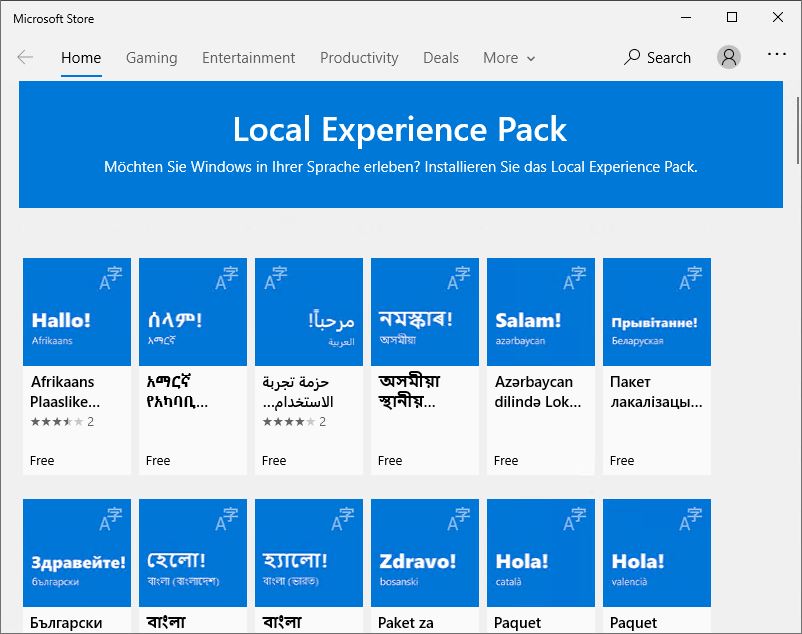
after clicking on the desired one, it well get downloaded and you see the following message if you would like to active the new language now:

Finally after a logoff and logon you will have a new language for your user.
Seems to be easy and straight forward and the job is done, right? Not in my opinion. We have configured the UI language for the current user but not the UI language of the logon screen for example. I do get the concept of switching the user and not the logon screen to maintain base language and individual user languages, but if I look at my customer base they are not depending on this, they rather depend on a device delivered in english and then they want to switch this completely to german for example. Most devices are used by one user, the primary user. So, the first question I always get with this approach is why is my logon screen still english?
Additionally I find this solution not complete as we have a few more settings to reconfigure a device from e.g. english to german. In my opinion a complete switch should include the Regional Settings, Speech, and Input etc.
What can we do to achieve a comfortable language switch for the user?
A general approach I see is to use the Intune and Microsoft Store for Business (MSfB) integration. This way you add the language pack (online) version to the MSfB and assign it in Intune to the user as available or to a device as required. Assigned to a user would look like this:
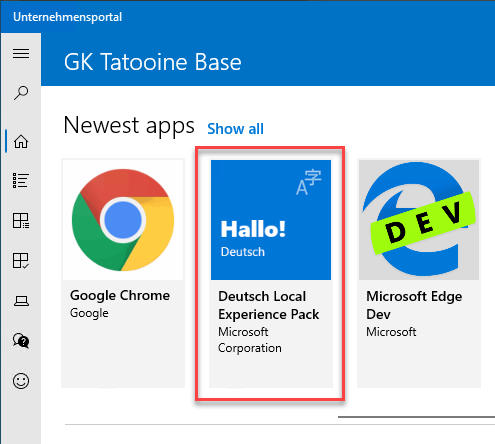
If we assign it to the device as a required install, it will get provisioned but never activated (entry Deutsch is added in this example from the required install):
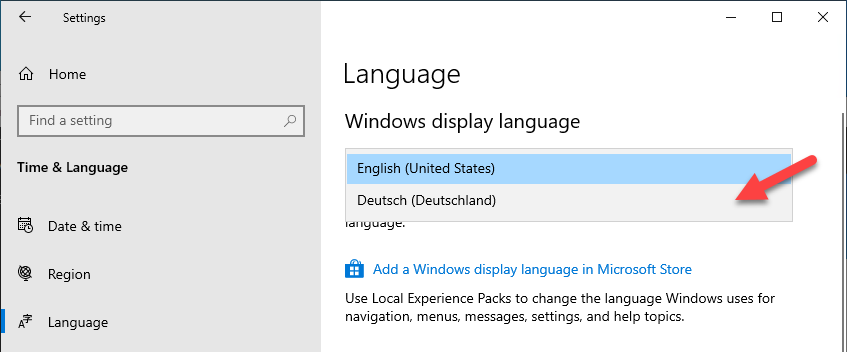
Typically people start to target a PowerShell user script (running in user context) which includes the following code:
Set-WinUILanguageOverride -Language 'de-DE'
This switches the user session to the newly provisioned language pack.
It looks like it accomplishes the goal, but I’ve seen this approach failing when the language pack was not properly registered and the language entry was missing. In that situation the PowerShell command failed also during my tests. Additionally the fact that we belong for the language switch on two independent components (LXP as device assigned package and user PowerShell script which don’t know each other) looked to me that it may break quite easily. I looked for a solution to switch the language and all other necessary settings in one sequence.
The approach from Michael Niehaus used in the Autopilot Branding uses language cab files and the intl.cpl with the xml GlobalizationUnattend file. This would achieve my goal to switch completely as the input xml file for the intl.cpl does have all necessary settings and can be set during system context. Meaning we can install the language cab files at the device setup phase and switch the language. A new user logging on after that will have the correct language. Downside of this approach, I don’t like to maintain the language cab files in the package for every new Windows 10 version.
What is the solution to not rely on language cab files?
The idea is to download the language experience pack (LXP) just in time and reconfigure the device. Microsoft provides a MDM Bridge WMI Provider to execute MDM functions. As Intune is able to trigger an install of an online language experience pack we should be able to call the same MDM install function from the MDM Bridge WMI Provider. There are two great articles to find all necessary information to get going:
The first article describes the usage of the MDM Bridge WMI Provider and the second one describes the actual Configuration Service Provider (CSP) to install Store applications. As the Language Experience Packs are Store applications, this is all we need and this is the same CSP Intune is using to install the LXP. The EnterpriseModernAppManagement CSP has some requirements to “Deploy apps to user from the Store“:
- The app is assigned to a user Azure Active Directory (AAD) identity in the Store for Business. You can do this directly in the Store for Business or through a management server.
- The device requires connectivity to the Microsoft Store.
- Microsoft Store services must be enabled on the device. Note that the UI for the Microsoft Store can be disabled by the enterprise admin.
- The user must be signed in with their AAD identity.
The is a SyncML example where we can find necessary information how to use the CSP:
<Exec>
<CmdID>1</CmdID>
<Item>
<Target>
<LocURI>./User/Vendor/MSFT/EnterpriseModernAppManagement/AppInstallation/{PackageFamilyName}/StoreInstall</LocURI>
</Target>
<Meta>
<Format xmlns="syncml:metinf">xml</Format>
</Meta>
<Data><Application id="{ProductID}" flags="0" skuid=" "/></Data>
</Item>
</Exec>
From interest is the part {PackageFamilyName} and StoreInstall. StoreInstall describes our function we have to look for with the MDM Bridge WMI Provider and the {PackageFamilyName} is the Store app we want to install. In the <Data> tag we find the parameter for the StoreInstall function. There we have to lookup the individual parts:
- {ProductID}, this value is acquired as a part of the Store for Business management tool.
- The value for flags can be “0” or “1”. When using “0” the management tool calls back to the Store for Business sync to assign a user a seat of an application. When using “1” the management tool does not call back in to the Store for Business sync to assign a user a seat of an application. The CSP will claim a seat if one is available.
- The skuid is a new parameter that is required. This value is acquired as a part of the Store for Business to management tool sync.
Let’s have a look into the CSP in WMI:

There it is, the WMI class and a StoreInstallMethod to initiate an install process. If we follow the guide Using PowerShell scripting with the WMI Bridge Provider we can build a PowerShell script to install the store app via PowerShell. Keep in mind that we have to lookup all the values like PackageFamilyName (PFN), ProductID, SKUID.
A good way to find the PFN is documented her: Find a package family name (PFN) for per-app VPN. The basic steps are:
- Go to https://www.microsoft.com/store/apps
- Enter the name of the app in the search bar. In our example, search for OneNote.
- Click the link to the app. Note that the URL that you access has a series of letters at the end. In our example, the URL looks like this:
https://www.microsoft.com/store/apps/onenote/9wzdncrfhvjl - In a different tab, paste the following URL,
https://bspmts.mp.microsoft.com/v1/public/catalog/Retail/Products/<app id>/applockerdata, replacing<app id>with the app id you obtained from https://www.microsoft.com/store/apps – that series of letters at the end of the URL in step 3. In our example, example of OneNote, you’d paste:https://bspmts.mp.microsoft.com/v1/public/catalog/Retail/Products/9wzdncrfhvjl/applockerdata.
If we do this for the german LXP we will find the App ID and PFN:
Application ID: 9p6ct0slw589 PackageFamilyName: Microsoft.LanguageExperiencePackde-DE_8wekyb3d8bbwe SKU ID: 0016
PackageFamilyName is easy to construct for other packages as 8wekyb3d8bbwe is the PublisherId for Microsoft and therefore the en-US PackageFamilyName is constructed by replacing the de-DE with en-US -> Microsoft.LanguageExperiencePacken-US_8wekyb3d8bbwe. For the SKU ID just open the Microsoft Store for Business and have a look at the URL:
https://businessstore.microsoft.com/en-us/manage/inventory/apps/9P6CT0SLW589/0016/00000000000000000000000000000000
If have seen only 16 until now. So the main part for other languages will be to get the Application ID then.
The gathered information is enough information to create a short PowerShell script to validate the MDM Bridge WMI Provider if we can successfully install the german language experience pack:
After execution in system context and a quick check we can see the Language Experience Pack for german was downloaded and installed:

This builds the basis for our script to completely switch the language without language cab files.
What do we need to do now in total for a scripted solution?
We run a PowerShell script in system context (system context is needed for the MDM Bride WMI Provider) and executing the following steps:
- Usage of the MDM Bridge WMI Provider and StoreInstallMethod to install LXP from the Store
- Call dism /online /Add-Capability /CapabilityName: to install Feature on Demand (FOD) packages from Windows Update
- Language.Basic~~~de-DE~0.0.1.0,
- Language.Handwriting~~~de-DE~0.0.1.0,
- Language.OCR~~~de-DE~0.0.1.0,
- Language.Speech~~~de-DE~0.0.1.0,
- Language.TextToSpeech~~~de-DE~0.0.1.0
If FODs are not installed, it may happen that you will see a UAC dialog right after restart, if the user is a standard user and doesn’t have administrative permissions:
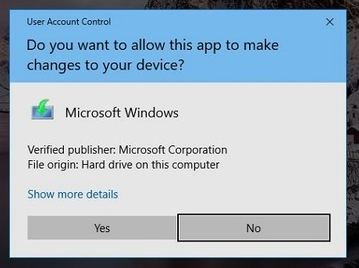
- Schedule and trigger a user script (which runs in user context) to switch the current user session to the new language defaults. Also make sure the language pack is registered in the current user session. This was during testing often an issue for me as the language was simply not switched from time to time if I did not explicitly register it in user context (Add-AppxPackage -Register …).
$appxLxpPath = (Get-AppxPackage | Where-Object Name -Like *LanguageExperiencePackde-DE).InstallLocation
Add-AppxPackage -Register -Path "$appxLxpPath\AppxManifest.xml" -DisableDevelopmentMode
Set-WinUILanguageOverride -Language de-DE
Set-WinUserLanguageList de-DE -Force
Set-WinSystemLocale -SystemLocale de-DE
Set-Culture -CultureInfo de-DE
Set-WinHomeLocation -GeoId 94
- Enforce the language change to be reflected by the OS more quickly by calling the scheduled task “\Microsoft\Windows\LanguageComponentsInstaller\ReconcileLanguageResources“, otherwise Windows Settings for example takes some fairly long time to fully switch to the new the language
- Call the well known intl.cpl,,/f:<path-to-language-config-xml> to switch the “Welcome screen” and “New user” language defaults
<gs:GlobalizationServices xmlns:gs="urn:longhornGlobalizationUnattend">
<!-- user list -->
<gs:UserList>
<gs:User UserID="Current" CopySettingsToDefaultUserAcct="true" CopySettingsToSystemAcct="true"/>
</gs:UserList>
<!-- GeoID -->
<gs:LocationPreferences>
<gs:GeoID Value="94"/>
</gs:LocationPreferences>
<!-- UI Language Preferences -->
<gs:MUILanguagePreferences>
<gs:MUILanguage Value="de-DE"/>
</gs:MUILanguagePreferences>
<!-- system locale -->
<gs:SystemLocale Name="de-DE"/>
<!-- input preferences -->
<gs:InputPreferences>
<gs:InputLanguageID Action="add" ID="0407:00000407" Default="true"/>
</gs:InputPreferences>
<!-- user locale -->
<gs:UserLocale>
<gs:Locale Name="de-DE" SetAsCurrent="true" ResetAllSettings="false"/>
</gs:UserLocale>
</gs:GlobalizationServices>
- Finally trigger the MS Store to get Updates for the apps due to the language change. This is done also by using the MDM Bridge WMI Provider
Get-CimInstance -Namespace "root\cimv2\mdm\dmmap" -ClassName "MDM_EnterpriseModernAppManagement_AppManagement01" | Invoke-CimMethod -MethodName "UpdateScanMethod"
As we have the restriction for the StoreInstallMethod to have an AAD user logged on, we can’t use the script to run in ESP and device preparation phase. I ended up creating a Win32 app package in Intune to give users the ability to run it by them self. To make it pretty I used the same language image from the Store:
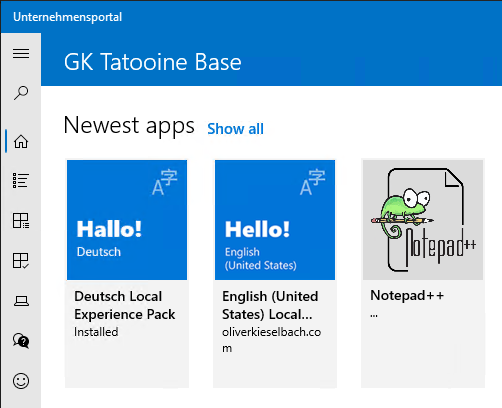
This way we can also request the mandatory reboot:
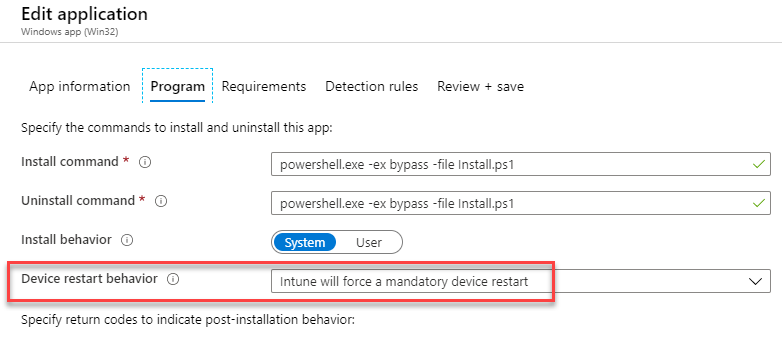
On the assignment we define the restart grace period and snooze duration:

For the detection of the Intune Win32 app I’m using a custom PowerShell detection script to check for a custom registry key which is written by the language script. I’m using a custom registry key and do not check for the actual LXP as I want to prevent a flip-flop situation when you have e.g. de-DE and en-US assigned to a user and he is able to choose by his own. After install of the second LXP and a detection of actual LXP or UI language, it would result in IME trying constantly to apply the apps, as one detection would always fail and the app would be re-applied.
$language = "de-DE"
$app = "SetLanguage-$language"
$property = Get-ItemProperty -Path HKLM:\Software\MyIntuneApps -Name $app -ErrorAction SilentlyContinue
if ($property.$app -eq 1) {
Write-Output "$app detected."
}
The final script logs all activities to the corresponding session context temporary folders which are the following. The filename includes the language tag like de-DE or en-US at the end:
- C:\Windows\Temp\LXP-SystemContext-Installer-de-DE.log for system context execution
- C:\Users\<username>\AppData\Local\Temp\LXP-UserSession-Config-de-DE.log for user context execution
How does the language switch experience look like for the user?
If a user installed the published app to switch to ‘de-DE’ from an ‘en-US’ Windows 10 it looks like this:

followed the mandatory reboot with grace period and snooze capability:
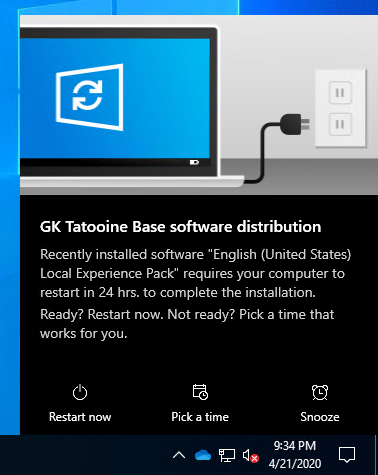
he will see the new language default in ‘de-DE’ even on the welcome and logon screen:
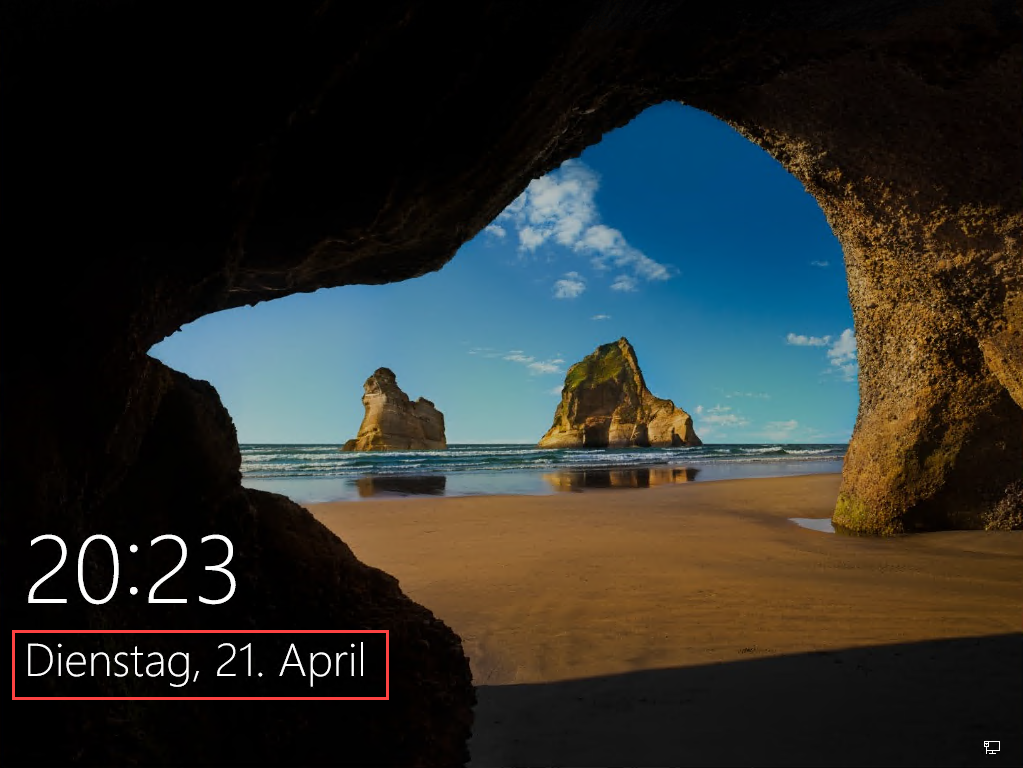
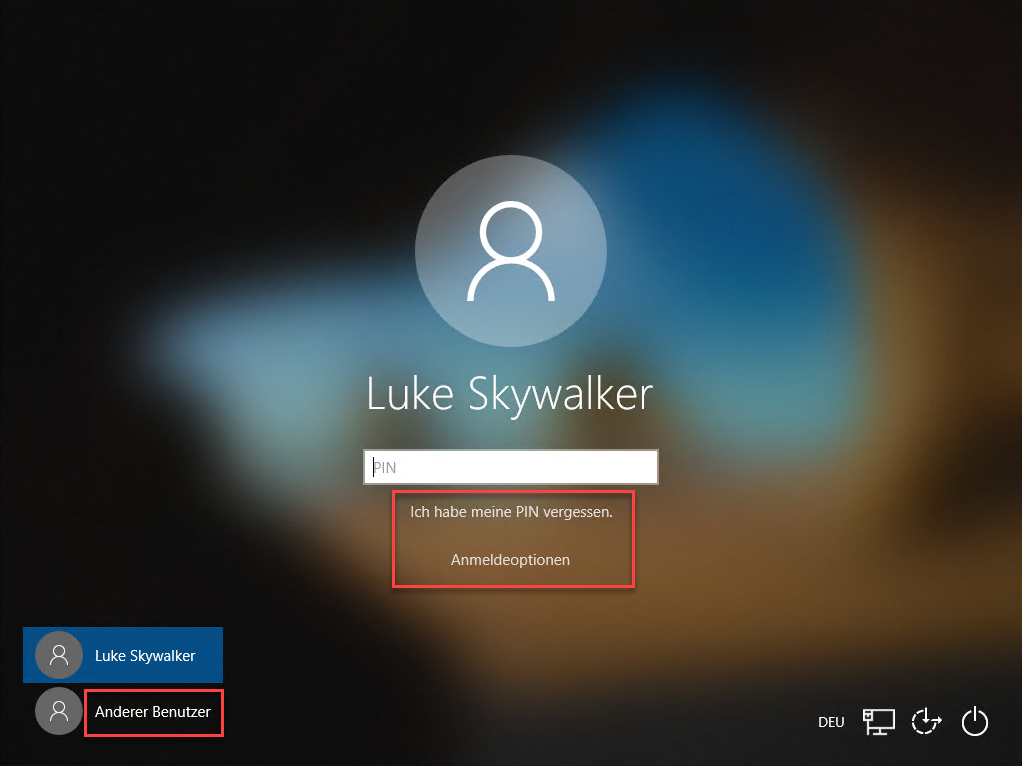
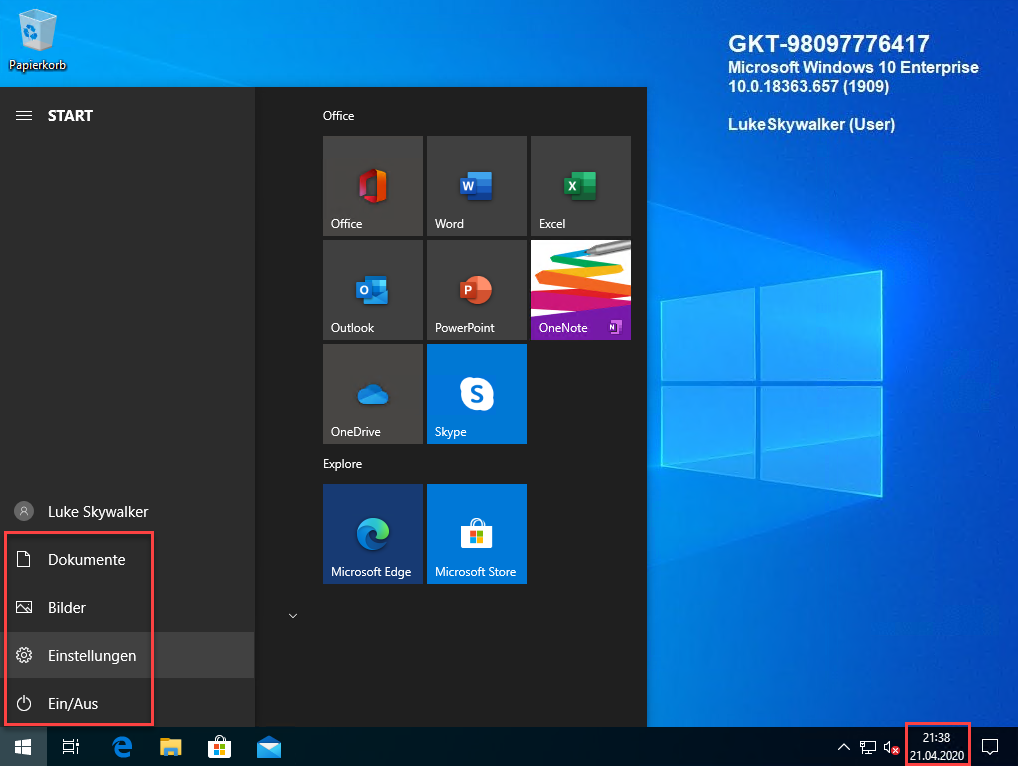
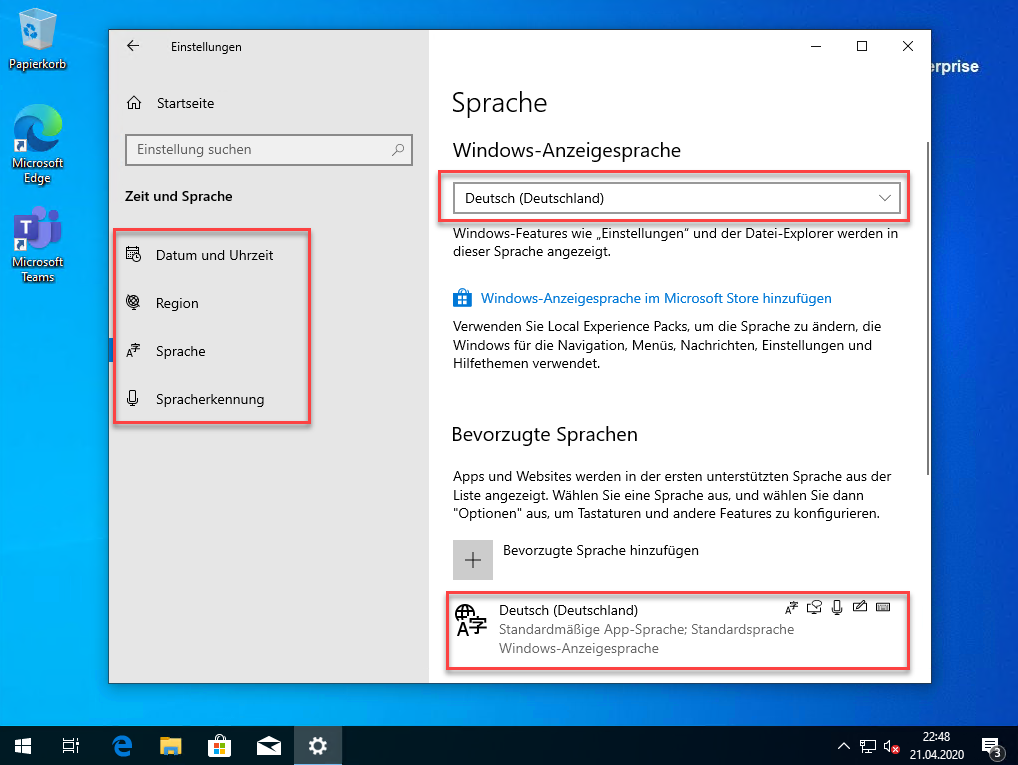
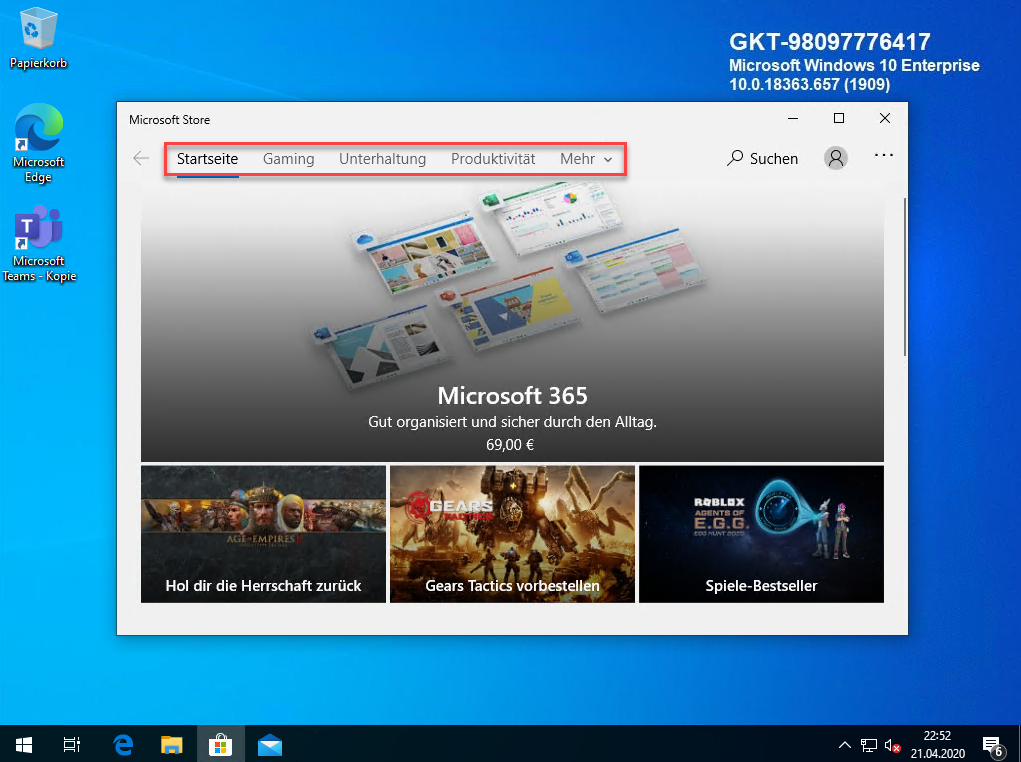
How are the results and conclusions?
I tested the script in virtual machines on Hyper-V and did the following language switches to verify correct behavior:
‘en-US‘ base installation -> switch to ‘de-DE‘ -> switch back to ‘en-US‘
‘de-DE‘ base installation -> switch to ‘en-US‘ -> switch back to ‘de-DE‘
All the language switches were done with Pro and Enterprise Editions, Windows 10 versions 1809, 1903 and 1909, and in all situations it went well. I did no test with production devices or devices running for a longer time (greater device lifetime). I did more or less lab environment tests.
Keep in mind if the environment has Enterprise State Roaming (ESR) enabled some settings might get roamed and overwritten and may cause confusion during testing with multiple devices and the same user. ESR roams the following settings:
Language preferences, which include settings for keyboard layouts, system language, date and time, and more.
Reference: https://docs.microsoft.com/en-us/azure/active-directory/devices/enterprise-state-roaming-faqs
Modern Apps like the MS Store app itself took always some time after it finally switched the language to german. As soon as the Updates for the Modern apps are finished the Store was displayed also in german.
Another issue seems to be the Company Portal. It does not reliably switch the language. Maybe it is affected by ESR and roaming setting or something else. At the time of writing I couldn’t finally clarify this.
UPDATE: I’m now aware of the language handling and store apps, see here the quick fix:
Company Portal stuck in a different language?
The final solution and possible enhancements
The final script itself brings a variety of options. As we have control over every language aspect and running everything in one sequence we can enhance the script to our needs. For example regions which are using special keyboards, different from the UI language can easily be handled in the script. This makes it possible to build a de-CH language pack which installs german UI and ‘de-CH’ input language for example. A sample Win32 app package for de-DE is available on my GitHub, it can be easily modified for other languages, see txt files:
SetLanguage-de-DE – Intune Win32 app files
https://github.com/okieselbach/Intune/tree/master/Win32/SetLanguage-de-DE
For further automation we could play around with some Requirement rules on the Intune Win32 app package. One idea is to assign the package as required and the requirement rule checks if the Enrollment Status Page (ESP) has finished. This way we could allow the app to run only if the ESP has finished. It would make sure that the app is executed when the AAD user is logged on and the InstallStoreMethod can successfully install the language experience pack. The problem is that I’ve seen during my tests, that the ESP indicator for this HasProvisioningCompleted in the WMI class MDM_EnrollmentStatusTracking_Setup01 is not reliable. I’ve seen several installations where the HasProvisioningCompleted status was False but I was in the Windows user session working already… This left an impression that I can’t rely on this WMI class. Which is strange as I think this is used for the Intune Management Extension as well. Here is the Requirement PowerShell snippet for this:
$namespace = "root\cimv2\mdm\dmmap"
$className = "MDM_EnrollmentStatusTracking_Setup01"
if ($(Get-WmiObject -Class $className -Namespace $namespace).HasProvisioningCompleted -eq "True") {
"Provisioning finished."
}
Anyway, during the tests I found it very comfortable to have the language switch app available in the Company Portal. For now it seems a good way to provide a complete language switch option for the users.
For me it’s a quite useful script and I’m in evaluation with real hardware.
I wish happy language configuration.
Further reading
Windows 10 Multilanguage Deployment with MEMCM
…a very good article with a similar approach by using LXP packages and ConfigMgr (without online LXP install by leveraging MDM Bridge WMI Provider)
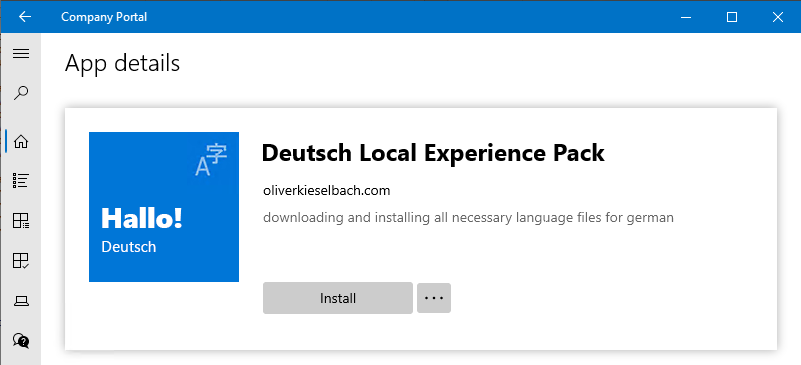
The simple workaround for delaying until after device ESP completes is to check if the current user is defaultUser* (typically defaultUser0, but it could be a different number in some circumstances). Just be aware that ESP will wait for “not applicable” apps because it doesn’t know any better, so you would have to exclude that app from the blocking list.
Thank you Michael, especially for the “not applicable” and ESP advice… This leads me to another question, is there the intention to raise the app count? I do have customers which are not happy with the 25 max limit when selected apps in ESP is chosen.
Hi there,
I couldn’t find any LXP language under “https://www.microsoft.com/store/apps” and therefore I can’t get the AppID. Also, when I loaded your example URL into the address bar, I don’t see the SKU ID:
https://bspmts.mp.microsoft.com/v1/public/catalog/Retail/Products/9p6ct0slw589/applockerdata
Hey Rick,
yes, that was not precisely described (I changed that 👍), have a look at the Microsoft Store for Business URL of the LXP. You find the information there.
best,
Oliver
Hi Oliver,
Do you know if this would also work with a classical domain joined system?
An example for me would be IPU being performed by MECM (SCCM) Servicing plan upgrading the base OS (English) then the user could install the Languages so it would behave similar to intune device.
Hey Darren,
As long as the Store for business has the language pack I guess it will work. The script itself is not a real issue, the only thing what could go wrong is the StoreInstall method call form the MDM Bridge WMI provider. I would suggest use the StoreInstall sample and try it out on one of your devices. If this works the full script should work also.
best,
Oliver
Hi Oliver,
ich verwende dein Skript, um ein deutsches Windows 10 auf Englisch zu schalten.
Leider wird hierbei das Zahlenformat auf Englisch gestellt. Könntest du mir sagen, wo ich das Skript anpassen muss, damit das deutsche Zahlenformat bestehen bleibt?
Gruß,
Adriano
Hey Adriano,
have a look at the “Set-Culture”, it is controlling the Regional Settings. In your case it would be needed to execute Set-Culture de-DE. So modify the script to make sure Set-Culture de-DE is executed. You can test this easily upfront by typing it into PowerShell and look if it fulfills your needs.
best,
Oliver
How do I run your script without Intune? I need to switch language of Azure Windows 10 VM from EN to DE permanently.
What I try to do is
1. Create VM from Marketplace Image Windows 10 English
2. Login to VM
3. Switch everything to German
4. Sysprep and Capture
5. Create new VM from Image -> should be German by default and as only language installed
6. Create new VM from Image -> should be German by default and as only language installed
7. Create new VM from Image -> should be German by default and as only language installed
and so on,,,
Hey Richard,
I think you can run the script in system context (with the help of psexec for example) and it should work. Not sure what restrictions you might have in the Azure VM environment but I think it should work.
best,
Oliver
Thank you. After running the script in system context I got the following error at the end of the log:
…trigger language change for current user session via ScheduledTask = LXP-UserSession-Config-de-DE
PS>TerminatingError(New-ScheduledTaskPrincipal): “Cannot validate argument on parameter ‘UserId’. The argument is null or empty. Provide an argument that is not null or empty, and then try the command again.”
**********************
So I think the scheduled task is not configured. I also found “C:\ProgramData\CustomTempScripts\UserConfig.ps1”. I did not found the logfile so I think the script never run. Who must run the script? System user or logged in user (local admin in my case)? Is this script used only once for my account or is it necessary to run the script regularly (once per hour / day / week?) for each user who will logon to this system?
I run final user part configs only once for the current logged on user, then the user task will be deleted. UserId is resolved by this: (Get-CimInstance –ClassName Win32_ComputerSystem | Select-Object -expand UserName), not sure why this is an issue….
I ran
Get-CimInstance –ClassName Win32_ComputerSystem | Select-Object -expand UserName
on my local machine and on my Azure VM.
My local machine returned Domain\User
Azure returned ‘null’ (aka nothing).
Good to know. I will come back to this problem later. Thank you for your incredible support @ night.
Encountered the same issue and found out that UserName is empty once I’m connected to my VM via RDP. Wenn I do a basic connection to my VM, the username from (Get-CimInstance –ClassName Win32_ComputerSystem | Select-Object -expand UserName) is returned correctly
Hey Oliver… I *love* this, it’s like you came forward in time and read my brain!…
I’m working on some en_US images and really want them to be en_GB with no faffing, and my brain was getting increasingly annoyed at blogs suggesting to upload the LXPs to blob storage etc when I knew there must be a way to get it from the store… then I found your blog, awesome stuff. 🙂
That said… I’m still really keen to try and automate the change without the user having to go select the language. They’re not autopilot machines (they’re VMs hosted elsewhere), so not sure ESP is going to be a thing…. What would you think, could a scheduled task be left on the machine to detect log in and then run it as system? A little like your bitlocker pin stuff but the other way around?
Thanks for the nice words :-). And yeah absolutely, the scheduled task approach I would try! The challenging part is more to clearly identify the correct situation to start the execution. Let me know how you progress, I’m happy to assist…
Quick question… “Install-LanguageExperiencePack-de-DE.ps1” I’ve been reading around the area where the MDM instance is triggered to install the Store app… That needs to be run in system context, but I’m in a muddle if it needs a user to be logged in or not, I don’t suppose you know? I can test, but thought I’d ask in case you remembered. 🙂 I only ask because one of the requirements you highlight is “The app is assigned to a user Azure Active Directory (AAD) identity in the Store for Business” but if no one’s logged in then there’s no user for the Store to have an app assigned to? Or doesn’t that matter if it’s available to everyone? (And also you’ve used the “flags = 1” i.e. “the management tool does not call back in to the Store for Business sync to assign a user a seat?”). Thanks!
Hi, This works great, thanks for the clear instructions. Im having issues with the logon screen default. When switching language from english to german, the logon screen keeps the english keyboard. Is there a way to also remove the english keyboard from the logon screen ?
Thanks!
Hi Henk,
actually, I set the logon screen language…
So it should change to the correct value…
best,
Oliver
Hi Oliver,
Love the article. I have been adapting it to suit some of the needs within our environment.
We typically have configs like nl-BE, fr-BE, en-BE
I created a little script that sets these configs appropriately (I guess):
$MUI = “fr-FR”
$ccode = “fr-BE“
$InputM = “080c:0000080c”
$Geo = “21”
Set-WinUILanguageOverride -Language $MUI
$langList = New-WinUserLanguageList $ccode
$langList[0].InputMethodTips.Clear()
$langList[0].InputMethodTips.Add($InputM)
Set-WinUserLanguageList -Force $langList
Set-WinSystemLocale -SystemLocale $MUI
Set-Culture -CultureInfo $ccode
Set-WinHomeLocation -GeoId $Geo
This correctly reflects into the Settings for the current user, but once the device is rebooted, I see a lot of these settings reverting to English (United States)
I can’t really detect the actual cause of these settings reverting. Note that nothing is configured in our environment that additionally manages these settings
Any idea what might be the cause?
kr
Tim
Hi Tim,
I think you might have interference with Enterprise State Roaming (ESR) https://docs.microsoft.com/en-us/azure/active-directory/devices/enterprise-state-roaming-overview… this feature will roam some Language settings.. so maybe you have the issue located there. Try to turn it off for the particular user, just for testing purpose.
best,
Oliver
Hi Oliver,
Thx for feedback. I checked this, but on the device I can see that ‘Sync Settings’ is set to ‘Off’ and in the Azure AD Admin Center when looking for devices linked to my account that sync settings and appdata the list is empty.
kr,
Tim
Hey Oliver… I’m stuck on a Windows 10 with US English, have used your script to get UK language packs on… but Office (which was installed before the OS language packs) defaults to US English. Any ideas on how to also automate changing the Office proofing language to match the newly installed OS language packs?
Normally Office 365 ProPlus is configured by default to “Office display language” -> “Match Microsoft Windows”… I checked my lab right now and a VM switched to german from English US with an Office ProPlus package containing both language packs (English US and German) switched automatically on this VM to german, like the setting is configured. It the Office 365 ProPlus language pack for English GB correctly listed on your device?
Thanks for the tips, will go and check!
I think maybe what I mean is not the display language, but the proofing language, I guess that’s what I was having problems with; US proofing language making UK spellings red underlined and no apparent way to easily change it via a policy. Will carry on playing. 🙂
Hi Oliver,
Nice article. My question is how can we achieve a display language bar in the taskbar and people can change the language by pressing Alt+Shift.
is there any script to achieve this?
PS: we have the O365 Office suite installed with English and French language via Intune.
Hi Ganesh,
I have to admit I don’t have a solution out of my head for this right now and didn’t do research for this. So can’t provide here something. Would be something to research for me as well.
best,
Oliver
Hello Oliver,
I’m having a problem trying to get OS language to English. We want keyboard to stay as Swedish but other messages should be in English. Error points out intl.cp comma. Any idea what’s wrong with that?
& $env:SystemRoot\System32\control.exe “intl.cpl,,/f:`”$languageXmlPath`””
Settings we are using:
$language = “en-US”
$applicationId = “9pdscc711rvf” # english
$packageFamilyName = ‘Microsoft.LanguageExperiencePacken-US_8wekyb3d8bbwe’ # english
$geoId = 244 # United States
$inputLanguageID = “041d:0000041d” # sv-SE
Script is ran in Intune
Run script as logged user: no
Enforce script check: no
64bit powershell: yes
BR
haru
Hey Harri Rundberg,
can you post the exact error message? It is a bit hard to predict what it can be without the error message. Many thanks.
best,
Oliver
Hi Oliver!
Seems like it was my error. I copy/pasted the code in text editor and it probably changed the text format. When i copied it to the powershell ISE everything worked correctly.
BR
haru
Hi, How would you go about doing this” delaying until after device ESP completes is to check if the current user is defaultUser*”
Yep valid option, Michael Niehaus proposed it as well in the first comment. 👍
Hi Oliver,
Thank you for a great article.
When you tested the “switch back to previous language”, was it using the “Reinstall” from the Company Portal?
Can’t seem to make this work as the detection script still sees the registry as set correctly I suppose.
Hey Andreas,
Many thx! Starting with English then used the script to change to German and then a second app (language script) switched back to English. So I had two apps (scripts) published in Company Portal, one German the other English. Reinstall will not work because of the reason you said 👍
Best,
Oliver
Alright, didn’t miss some smart workaround on that one then 😀 Deployed a script for each language for the autopilot deployment which seems to works great!
For the manual switching using the Company Portal I had to publish a separate script for each language with a detection registry key unique from the others, and have it remove the detection registry key for any other manual packages when installing. This way I seem to be able to switch back and forth only using the Company Portal continuously by just clicking “Reinstall” (Y)
Hi Oliver,
I use your script to test changing english to german.
Everything is fine except after reboot the german language will disappear in the preferred language list.
Did you have any idea?
By preferred language list doe you mean the list in the taskbar or in the Settings (the new control panel)?
Hello Oliver,
this script will only run once, did I get this right?
We have PCs with multiple users, and as a trading company, having the right decimal separator and list separator is crucial to us.
I achieved this via adding some “Set-ItemProperty” in the user script part.
Is there an easy way to let the skript run like every time?
You could probably enhance the script by dumping a user script with your needed settings on the disk like C:\ProgramData\CustomScripts\Language… and registering a scheduled task which runs on every user logon. Every scripting technique is used on my scripts to you could borrow parts to develop this additional part. That would be my approach.
Dear Oliver,
change script to nl-NL without isseu en works perfect. we are now testing
thanks
I’d really like to repurpose this script to run during preprov and add extra languages to the OS so when it boots up for the user they get to choose the language of the OS from the ones available. I’ve had zero luck with it though by just removing the steps that actually set things and leaving the ones that download and install things.
Am I flogging a dead horse here, is this not possible?
Hey Dan,
Never tried it this way, might work or not, not sure 🤷♂️. If you use Windows 11 22H2 then you could try to use the LanguagePack Management Modul and the cmdlet Install-Language.
best,
Oliver
I have been working on getting this script working for a client that i have. They need it so that they can change the language to fr-CA. There are a few things i am running into…
1. When the script runs it seems to have issues with the first user login but the second user to login seems to apply the language without issue. Is there something missing here?
2. When the language is changed, a fresh start of the device brings it to the OOBE page and it gives the option to select English or French. If you choose french the process fails immediately and forces you back to the selection. If you choose english (default OS when device was ordered) it goes through without issue. Is there something to make it so this does not happen?
Thxs for the really cool script, i use it for several languages